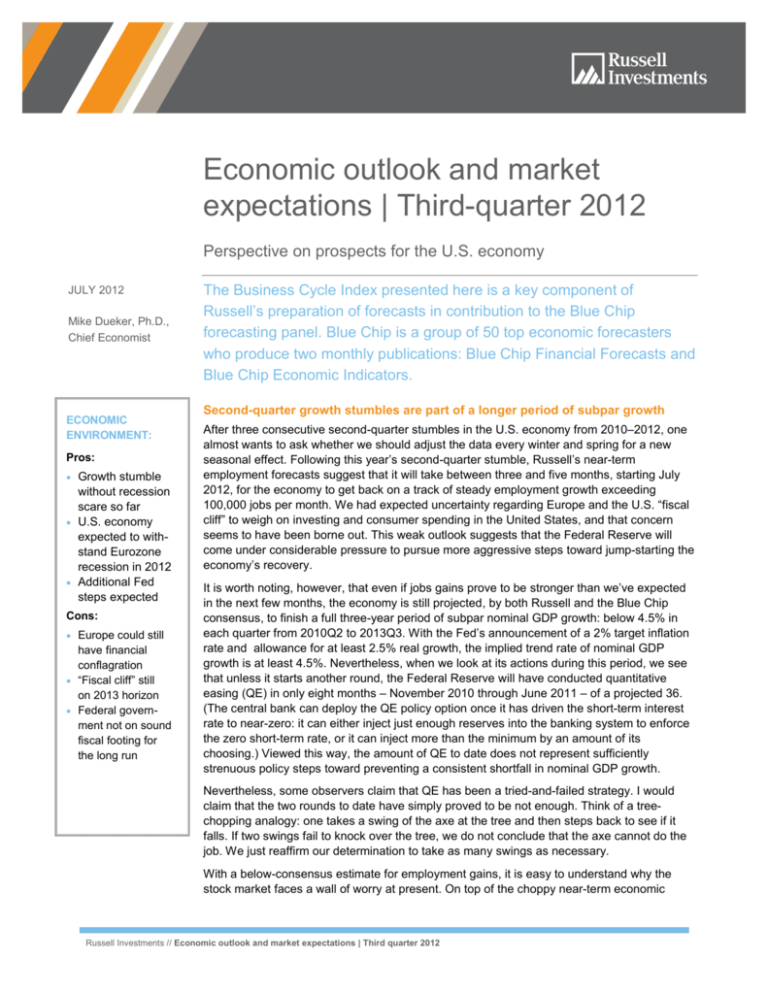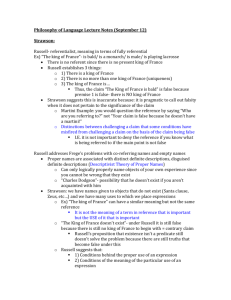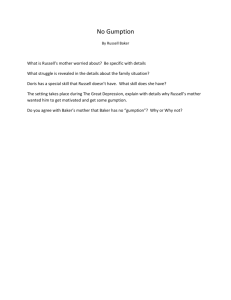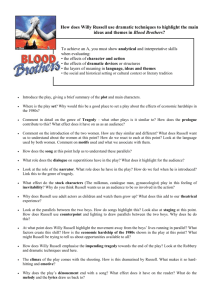
Economic outlook and market
expectations | Third-quarter 2012
Perspective on prospects for the U.S. economy
JULY 2012
Mike Dueker, Ph.D.,
Chief Economist
ECONOMIC
ENVIRONMENT:
Pros:
Growth stumble
without recession
scare so far
U.S. economy
expected to withstand Eurozone
recession in 2012
Additional Fed
steps expected
Cons:
Europe could still
have financial
conflagration
“Fiscal cliff” still
on 2013 horizon
Federal government not on sound
fiscal footing for
the long run
The Business Cycle Index presented here is a key component of
Russell’s preparation of forecasts in contribution to the Blue Chip
forecasting panel. Blue Chip is a group of 50 top economic forecasters
who produce two monthly publications: Blue Chip Financial Forecasts and
Blue Chip Economic Indicators.
Second-quarter growth stumbles are part of a longer period of subpar growth
After three consecutive second-quarter stumbles in the U.S. economy from 2010–2012, one
almost wants to ask whether we should adjust the data every winter and spring for a new
seasonal effect. Following this year’s second-quarter stumble, Russell’s near-term
employment forecasts suggest that it will take between three and five months, starting July
2012, for the economy to get back on a track of steady employment growth exceeding
100,000 jobs per month. We had expected uncertainty regarding Europe and the U.S. “fiscal
cliff” to weigh on investing and consumer spending in the United States, and that concern
seems to have been borne out. This weak outlook suggests that the Federal Reserve will
come under considerable pressure to pursue more aggressive steps toward jump-starting the
economy’s recovery.
It is worth noting, however, that even if jobs gains prove to be stronger than we’ve expected
in the next few months, the economy is still projected, by both Russell and the Blue Chip
consensus, to finish a full three-year period of subpar nominal GDP growth: below 4.5% in
each quarter from 2010Q2 to 2013Q3. With the Fed’s announcement of a 2% target inflation
rate and allowance for at least 2.5% real growth, the implied trend rate of nominal GDP
growth is at least 4.5%. Nevertheless, when we look at its actions during this period, we see
that unless it starts another round, the Federal Reserve will have conducted quantitative
easing (QE) in only eight months – November 2010 through June 2011 – of a projected 36.
(The central bank can deploy the QE policy option once it has driven the short-term interest
rate to near-zero: it can either inject just enough reserves into the banking system to enforce
the zero short-term rate, or it can inject more than the minimum by an amount of its
choosing.) Viewed this way, the amount of QE to date does not represent sufficiently
strenuous policy steps toward preventing a consistent shortfall in nominal GDP growth.
Nevertheless, some observers claim that QE has been a tried-and-failed strategy. I would
claim that the two rounds to date have simply proved to be not enough. Think of a treechopping analogy: one takes a swing of the axe at the tree and then steps back to see if it
falls. If two swings fail to knock over the tree, we do not conclude that the axe cannot do the
job. We just reaffirm our determination to take as many swings as necessary.
With a below-consensus estimate for employment gains, it is easy to understand why the
stock market faces a wall of worry at present. On top of the choppy near-term economic
Russell Investments // Economic outlook and market expectations | Third quarter 2012
outlook, the stock market also faces long-run investor concerns that tend to hold down
expansion of price-earnings multiples:
a)
Long-run fiscal concerns about the U.S. federal government. Our political
leaders need to walk a fine line between announcing long-term budget cuts
(especially to Medicare) and harming the fragile recovery by cutting spending too
quickly, as they look at the fiscal cliff.
b)
The Eurozone crisis. Investor reticence to hold peripheral European bonds
probably represents the first shot across the bow by bond-market vigilantes
concerned about unaffordable social welfare states. The common currency, and its
inherently fixed exchange rates, made the peripheral European Monetary Union
(EMU) countries vulnerable to being the vigilantes’ first points of attack.
c)
China’s precariously high investment-to-GDP ratio. The ratio is elevated to nearrecord levels to sustain China’s high growth rates now, but could be leading to
investments that fail to generate satisfactory rates of return in the future.
Looking at the second half of the year, we do not expect significant progress toward
alleviating these three long-run investor concerns, as policymakers continue to delay making
hard choices.
Near-term U.S. growth outlook: a tug-of-war between improved business cycle
conditions and weak employment gains
The Business Cycle Index (BCI) that is posted each month on Russell.com suggests that
U.S. business cycle conditions hit the bottom of the recent stumble in June 2012 and will
rebound gradually from there. For equity markets, a typical pattern has been stock prices
start to climb within three months of the bottom of a cycle. This time, however, we have a
weaker-than-consensus outlook for employment gains for at least five full months beyond
June 2012. Through this employment lens, Russell’s view is that more bad news awaits
investors, which would tend to hold down stock price appreciation. It is unclear how these two
conflicting signals will play out in the macroeconomic data and in the stock market, especially
during a period when policymaker decisions play a massive role in shaping market sentiment.
The only bright spot in the macroeconomic outlook is that double-dip recession fears have
been relatively muted in the 2012 second-quarter stumble, in contrast to the 2010 and 2011
stumbles. Instead, investors see longer-term-growth problems in the United States. As of July
19, 2012, the negative real yields on Treasury inflation-protected securities now extend out to
20-year bonds. It was shocking when the real yield on 5-year indexed bonds went to below
zero in 2010; but now the 20-year indexed bonds have a real yield below zero, and the 5year bonds have a real yield below –1. For government deficit projections, these expectations
are a two-edged sword: the government would not need to pay high interest on debt, but the
tax base would not grow at a decent pace, either.
Here are the details of our U.S. economic outlook for the remainder of 2012:
Real GDP growth is expected to be only 1.9% on a year-on-year basis in 2012.
Nevertheless, even this muted growth outlook is based on central-tendency forecasts
predicated on there not being a full-bore financial meltdown in Europe.
Our baseline forecast is that the ongoing economic recovery in the United States can
withstand Europe’s recession unless the Eurozone experiences a full-fledged financial
meltdown.
We project non-farm payroll employment gains to average less than 100,000 jobs in
each of the remaining six months of 2012; our projection is lower than the latest Blue
Chip consensus forecast of 119,000.
Russell Investments // Economic outlook and market expectations | Third quarter 2012
/ p2
Russell projects that the benchmark 10-year Treasury yield will end the year at about
1.9%. If this scenario unfolds, the U.S. economy will not exit Japan-style stagnation
expectations until well into 2013.
Inflation outlook: Russell projects that the All-Items CPI will increase at an average rate
of 1.9% in 2012 and by 2.1% in 2013. Inflation fighting does not appear on the Fed’s
radar screen until 2014, at the earliest.
Focus on the Fed
As discussed above, the economy is in the midst of a three-year period of subpar nominal
GDP growth, during which the Federal Reserve has thus far conducted quantitative easing
(QE) only between November 2010 and June 2011: eight months out of a projected 36. Thus,
course correction from the Fed is expected, with additional QE. I would expect a third round
of QE to include purchases of mortgage-backed securities (MBSs) in addition to Treasury
bonds. While the Fed would like to encourage a broad range of commercial and industrial
lending, MBS have an advantage in the clear lending standards now employed at Fannie
Mae and Freddie Mac that make them a safer, non-controversial asset for the Fed to acquire
from the private sector.
Some market watchers also expect Fed policymakers to clarify their objectives for QE,
because if the public buys into the plan, it can help bring those objectives to fruition. Charles
Evans, president of the Federal Reserve Bank of Chicago, has suggested that the Fed might
aim temporarily at 3% inflation, rather than the long-run target of 2%. Alternatively, Fed
policymakers could announce a nominal GDP growth target; doing so would help them avoid
making an awkward announcement of an explicitly higher inflation objective. Any extra
inflation that would take place under a nominal GDP target would be the result of a shortfall in
real growth. Nevertheless, announcing a nominal GDP target would entail the risk that the
Fed could miss the target badly if the U.S. economy were to go into recession for a reason
beyond the Fed’s control, such as a financial meltdown in Europe or a Congressional dive off
the fiscal cliff. Nevertheless, the basic rationale for a third round of QE appears to be an
inescapable conclusion: to do its part, the Fed needs to do more.
Russell Investments // Economic outlook and market expectations | Third quarter 2012
/ p3
Figure 1: U.S. Business Cycle Index
Standard deviations from zero
3
Out of sample
forecasts
2
1
0
-1
-2
Gray Bars
Indicate Periods
of Recession
-3
-4
Data as of July 2012
Out of sample forecasts were calculated by simulating the time-series model into the future.
The value shown is the median of the simulated value for the month.
Source: Recession data from National Bureau of Economic Research
Figure 2: Non-farm payroll employment changes
Jobs (in thousands)
300
0
-300
-600
-900
Forecast Dec 08
Data Dec 08
Data Jun 12
Forecast Jun 12
Data and forecasts as of December 2008 and actual data through June 2012
Source: Actual employment data from St. Louis Fed's FRED database
Forecasting represents predictions of market prices and/or volume patterns utilizing varying analytical data.
There is no guarantee that the stated results will occur.
Indexes are unmanaged and cannot be invested in directly.
Historical data is not indicative of future results.
Russell Investments // Economic outlook and market expectations | Third quarter 2012
/ p4
Figure 3: Forecasts for nonfarm payroll employment changes
Jobs (in thousands)
300
0
-300
-600
-900
Actuals
Forecast
Data as of June 2012
Source: Actual employment data from St. Louis Fed's FRED database
Figure 4: Forecasts for GDP growth: Blue Chip consensus and Russell's
forecast
3.5
Annualized growth (%)
3.0
2.5
2.0
1.5
1.0
0.5
2012Q2
2012Q3
Russell
2012Q4
2013Q1
2013Q2
2013Q3
2013Q4
Blue Chip
Source: Blue Chip Financial Forecasts, June 2012 issue
Forecasting represents predictions of market prices and/or volume patterns utilizing varying analytical data.
There is no guarantee that the stated results will occur.
Historical data is not indicative of future results.
Russell Investments // Economic outlook and market expectations | Third quarter 2012
/ p5
Figure 5: Forecasts for CPI Inflation: Blue Chip consensus and Russell's
forecast
3.0
Annualized growth (%)
2.5
2.0
1.5
1.0
0.5
2012Q2
2012Q3
Russell
2012Q4
2013Q1
2013Q2
2013Q3
2013Q4
Blue Chip
Source: Blue Chip Financial Forecasts, June 2012 issue
Forecasting represents predictions of market prices and/or volume patterns utilizing varying analytical data.
There is no guarantee that the stated results will occur.
Historical data is not indicative of future results.
Russell Investments // Economic outlook and market expectations | Third quarter 2012
/ p6
Perspectives on the prospects for the global economy
In the Eurozone, peripheral countries, such as Spain, are not receiving
the twin policies they need: higher nominal GDP growth and subsidized
interest rates on government debt.
The focus shifts to Spain
GLOBAL ECONOMIC
ENVIRONMENT:
Pros:
Can policymakers
be counted on to
avert the worst
outcomes?
Emerging markets
look comparatively
young and stable
Risks in China are
not near-term risks
Cons:
RE: Europe, can
anyone give an
example of reducing
an overvalued real
exchange rate
through deflation
with a fixed
exchange rate?
Asian economies
must adapt to slowgrowing developed
world
How high will food
prices go?
In the first decade of the euro, Spain positioned itself as the Florida of the Eurozone: a
retirement paradise for northerners. This expectation led to a housing construction boom that
came crashing down as concerns about the viability of the European Union came into
question. Imagine how Florida would fare in attracting retirees if there were a fear that their
Medicare coverage would no longer follow them to Florida. That is the situation with Spain
today. If Spain were unable to continue in the currency union, it also would be forced to
withdraw from the European Union. In this case, the EU system of transfer, in particular
funds which Germany and the Netherlands, for example, send to Spain to pay for health care
coverage for German and Dutch retirees in Spain would come to an end. For this reason, it is
vital that existential fears about EU membership be arrested soon if conditions in Europe are
to be stabilized.
Spain entered the Global Financial Crisis with a comparatively low debt-to-GDP ratio, but its
solvency is in question, because there is no foreseeable way to arrest the upward climb of its
debt-to-GDP ratio as long as it is mired in recession and its borrowing costs are high and
rising. What Spain needs, then, is a higher rate of nominal GDP growth resulting from looser
European Central Bank policies, as well as subsidized, below-market interest rates on its
public debt. After two and a half years of a crisis atmosphere in Europe, we are still awaiting
official recognition that a country such as Spain is going to need subsidized borrowing rates
to survive as a Eurozone member. The only recent development on this front came from
Mario Draghi, president of the European Central Bank (ECB) on July 26, 2012. He said that
“Within our mandate, the ECB is ready to do whatever it takes to preserve the euro. And
believe me, it will be enough." 1 His comments suggest that the ECB will not stand idly while
high interest expenses drive member countries, such as Spain, inexorably toward insolvency.
Eventually, however, the ECB will need a partner European entity, such as the European
Stability Mechanism, to formalize an interest rate subsidy because the ECB can provide only
stop-gap bond purchases. German policymakers, however, oppose ECB bond purchases of
sovereign bonds on the grounds that such bond buying crosses the clear line of separation
they believe should exist between monetary and fiscal policies.
The currently unsustainable status quo impairs the growth outlook for the entire Eurozone.
The first graph in this section shows the results of comparing a Eurozone Business Cycle
Index with the U.S. Business Cycle Index discussed earlier. Whereas the projected path of
business cycle conditions in the United States looks relatively mediocre, the projected path
for Europe is dismal. While the current recession is not expected to last long, the lack of a
recovery suggests that the Eurozone is poised to have a Japan-style “lost decade” of
economic stagnation.
The figures below illustrate the current Eurozone recession and highlight why the relevant
question in Europe is when decent growth will take place after the current recession ends, as
opposed to how long or deep the current recession will be. The graphs show a counterpart
1
Dunkley, J. (2012, July 26). “Debt crisis: Mario Draghi pledges to do 'whatever it takes' to save euro”. Retrieved on
July 30, 2012, from The Telegraph. available at: http://www.telegraph.co.uk/finance/financialcrisis/9428894/Debtcrisis-Mario-Draghi-pledges-to-do-whatever-it-takes-to-save-euro.html
Russell Investments // Economic outlook and market expectations | Third quarter 2012
/ p7
Eurozone Business Cycle Index (with out-of-sample forecasts) relative to the U.S. Business
Cycle Index that is posted each month on Russell.com.
A shot across the bow
Many commentators have been asking where the bond market vigilantes are vis-à-vis the
United States, given that bond yields remain relatively low, even following the downgrade of
U.S. government debt. The answer might be that they have already begun to attack
unsustainable social welfare states by concentrating their initial salvos on the peripheral
European Economic and Monetary Union (EMU) countries. It is the common currency, and its
inherently fixed exchange rates, that made these economies the most vulnerable to bond
market vigilantes.
United Kingdom (UK) falls into recession due to austerity and Eurozone vortex
We also estimated (with forecasts) a UK Business Cycle Index, using data through Q2 2012.
The projected path suggests that the UK’s recession is likely to be relatively short, although
the anticipated recovery is expected to be mediocre, somewhere between U.S. business
cycle conditions and Europe’s anemic economic state. It remains to be seen, however,
whether the Cameron government will ease the fiscal tightening taking place in Britain.
China’s soft landing
China’s 7.6% real GDP growth rate in the second quarter of 2012 (versus one year earlier)
was announced on July 14, 2012. This figure was right in line with consensus expectations.
China’s government has vowed to maintain near-term growth through increases in the
investment-to-GDP ratio if necessary. Thus, the biggest threat to the Chinese economy is the
medium-term risk that the current flurry of investment spending will not yield satisfactory rates
of return in the future.
Russell Investments // Economic outlook and market expectations | Third quarter 2012
/ p8
Figure 6: Eurozone and U.S. business cycle indices (1970-2012)
Sample standard deviations
4
3
2
1
0
-1
Enlarged below
-2
-3
Euro
U.S.
In-sample estimates | Out-of-sample forecast
Figure 7: Eurozone and U.S. business cycle indices (2007-2012)
Sample standard deviations
3
2
1
0
-1
-2
-3
Euro
U.S.
In-sample estimates | Out-of-sample forecast
Values shown for the in-sample estimates and out-of-sample forecasts are the median of the simulated
values for the quarter. Out-of-sample forecasts were calculated by simulating the time-series model into the
future.
Source: U.S. recession data from National Bureau of Economic Research. Europe recession data from the
Centre for Economic Policy Research. Recession for Europe in 2002 is based on research completed by
Mike Dueker, Ph.D., Russell Investments: http://research.stlouisfed.org/wp/more/2008-001
Forecasting represents predictions of market prices and/or volume patterns utilizing varying analytical data.
There is no guarantee that the stated results will occur.
Index performance is not indicative of the performance of any specific investment.
Indexes are not managed and may not be invested in directly.
Russell Investments // Economic outlook and market expectations | Third quarter 2012
/ p9
Sample standard deviations
Figure 8: UK and U.S. business cycle indices (1970-2012)
3
1
-1
Enlarged below
-3
UK
U.S.
In-sample estimates | Out-of-sample forecast
Source: Factset: European data as of June 30, 2012, Russell calculations: forecasts through June 30, 2015
Sample standard deviations
Figure 9: UK and U.S. business cycle indices (2007-2012)
2
1
0
-1
-2
-3
UK
U.S.
In-sample estimates | Out-of-sample forecast
Source: Factset: European data as of June 30, 2012, Russell calculations: forecasts through June 30, 2015
Forecasting represents predictions of market prices and/or volume patterns utilizing varying analytical data.
There is no guarantee that the stated results will occur.
Historical data is not indicative of future results.
Russell Investments // Economic outlook and market expectations | Third quarter 2012
/ p 10
Russell’s Market Expectations for Q3 2012
Signal date: July 1, 2012
WHERE ARE THE MARKETS GOING?
Several factors have led Russell Strategists to revert to a neutral policy weight for the asset class pairs tracked
below. More volatile assets look favorable from a valuation perspective using forward earnings expectations
and trailing earnings. However, valuation spreads are not as compelling as they have been in recent history
and relative price trends and growth concerns temper the optimistic outlook for these riskier assets. From a
macroeconomic perspective, uncertainty surrounding policy risks, like the U.S. fiscal cliff and the evolution of
the European debt crisis, causes Russell Strategists to be less confident in the strength of more fundamental
modeling signals, although they are constantly reassessing market valuations and will update
recommendations as appropriate.
Please remember that even in more normal market environments, the high level, simplified overview of our
market forecasts presented in this document does not reflect the fully nuanced asset allocation capability at
Russell and is not intended to be used as the basis for a trading strategy or asset class timing. Among other
things, a client’s individual risk tolerance and objectives, and more extensive details about the power and
alignment of the various model signals, would need to be taken into account to form a robust trading strategy.
Russell Investments // Economic outlook and market expectations | Third quarter 2012
/ p 11
Frequently Asked Questions
What is Russell’s Market Expectations?
This quarterly report provides Russell’s viewpoint on the direction of the market based on which asset
classes and currencies we think are undervalued as indicated by our proprietary models.
The information is used to estimate the relative performance of the two asset classes shown in the
pair. It does not provide insight into the absolute returns that an investor could expect. A model may
suggest that asset A will offer a higher return than asset B if the relative valuation between the two returns
to a historical level. However, the models do not suggest that asset A will provide a high return, simply a
return that may surpass that provided by asset B. The returns of both asset A and B could be negative.
The asset class and currency views are pair-wise comparisons, based on the relative value of each
asset class or currency, and reflect the valuation of asset classes or currencies that may be most
attractive compared to one another.
Russell’s proprietary models use financial theory, historical data and forecasts to measure relative
valuation.
Nothing contained in this material is intended to constitute legal, tax, securities, or investment advice, nor
an opinion regarding the appropriateness of any investment, nor a solicitation of any type. The general
information contained in this publication should not be acted upon without obtaining specific legal, tax, and
investment advice from a licensed professional.
Why is it important?
Russell’s Market Expectations can be used as a reference point for providing context and perspective
on the direction of the market and as a viewpoint on the attractiveness of different asset classes and
currencies.
Can I use Russell’s Market Expectations as an asset class-timing tool?
No. This report is not intended to be used as the basis for a trading strategy or as an asset classtiming tool.
The signals displayed in Russell’s Market Expectations are a high level overview of a limited subset of the
insights from Russell’s Enhanced Asset Allocation (EAA) Strategies and do not reflect the risk and
conviction controls that are part of the EAA portfolio customization.
How should I interpret it?
In simple terms, the chart shows you the relative valuation of asset classes for this quarter.
Each pair-wise expectation contains two important data points: the asset class we believe will outperform –
or a neutral expectation if we believe they will have similar performance – and, if applicable, the strength of
the outperformance. Moderate outperformance potential is indicated by a single plus sign (+), while
strong outperformance potential is indicated by two plus signs (++).
The boxes shown to the right gives you a view on which major currencies we believe will be stronger, or
weaker, than the U.S. dollar.
No model or group of models can offer a precise estimate of future returns available from capital markets.
We remain cautious that rational analytical techniques cannot predict extremes in financial behavior, such
as periods of financial euphoria or investor panic. Our models rest on the assumptions of normal and
rational financial behavior. Forecasting models are inherently uncertain, subject to change at any time
based on a variety of factors and can be inaccurate.
How often is it updated?
Russell’s Market Expectations is typically updated during the first month of each quarter. In the first quarter
of 2012 this communication will be updated in a timely manner if our strategists’ views on using the model
signals change, even if it does not fall in line with our normal quarterly reporting schedule.
Russell Investments // Economic outlook and market expectations | Third quarter 2012
/ p 12
FOR MORE INFORMATION, CONTACT YOUR RUSSELL REPRESENTATIVE.
Important information
Nothing contained in this material is intended to constitute legal, tax, securities or investment advice, nor an opinion regarding the
appropriateness of any investment, nor a solicitation of any type. The general information contained in this publication should not be
acted upon without obtaining specific legal, tax and investment advice from a licensed professional.
These views are subject to change at any time based upon market or other conditions and are current as of the date at the beginning of
the document. The opinions expressed in this material are not necessarily those held by Russell Investments, its affiliates or subsidiaries.
While all material is deemed to be reliable, accuracy and completeness cannot be guaranteed. The information, analysis and opinions
expressed herein are for general information only and are not intended to provide specific advice or recommendations for any individual
or entity. Forecasting represents predictions of market prices and/or volume patterns utilizing varying analytical data. It is not
representative of a projection of the stock market, or of any specific investment.
Diversification and strategic asset allocation do not assure profit or protect against loss in declining markets.
Please remember that all investments carry some level of risk, including the potential loss of principal invested. They do not typically grow
at an even rate of return and may experience negative growth. As with any type of portfolio structuring, attempting to reduce risk and
increase return could, at certain times, unintentionally reduce returns.
Forecasting represents predictions of market prices and/or volume patterns utilizing varying analytical data. It is not representative of a
projection of the stock market, or of any specific investment.
Indexes are unmanaged and cannot be invested in directly.
Historical data is not indicative of future results.
Russell Investment Group, a Washington USA corporation, operates through subsidiaries worldwide, including Russell Investments, and
is a subsidiary of The Northwestern Mutual Life Insurance Company.
The Russell logo is a trademark and service mark of Russell Investments.
Copyright © Russell Investments 2012. All rights reserved. This material is proprietary and may not be reproduced, transferred or
distributed in any form without prior written permission from Russell Investments. It is delivered on an “as is” basis without warranty.
First used: July 2012
USI-14062-07-13
Russell Investments // Economic outlook and market expectations | Third quarter 2012
/ p 13







